- Unleashing the potential of ceramic discards as a green marvel in self-compacting concrete
P. Subashreea,*, V. Sampathkumarb, S. Gowthamc, Abeer A. AlObaidd and Ismail Warade
aDepartment of Civil Engineering, Sri Krishna College of Technology, Coimbatore, Tamilnadu, India-641042
bDepartment of Civil Engineering, Kongu Engineering College, Perundurai, Erode, Tamilnadu, India-638060
cDepartment of Civil Engineering, Kongunadu College of Engineering and Technology, Trichy, Tamilnadu, India-621215
dDepartment of Chemistry, College of Science, King Saud University, P.O. Box 2455, Riyadh 11451, Saudi Arabia
eDepartment of Chemistry, AN-Najah National University, P.O. Box 7, Nablus, PalestineThis article is an open access article distributed under the terms of the Creative Commons Attribution Non-Commercial License (http://creativecommons.org/licenses/by-nc/4.0) which permits unrestricted non-commercial use, distribution, and reproduction in any medium, provided the original work is properly cited.
A nation’s ability to advance depends heavily on its infrastructure, which is frequently built using concrete. Self-compacting concrete (SCC) is well-liked for its mechanical, durability and workability. But there is a problem: natural aggregate is scarce. In light of the depletion of natural resources, investigating substitute materials is essential to maintaining building quality. The ceramic tile business has developed into a highly industrialized sector within the last 20 years, producing a large amount of trash. This trash presents environmental risks and pollutes the air, water, and land since it is made up of ceramic combinations. The environment and public health are adversely affected by around 30% of the trash produced every day in the ceramics industry. Although some research points to the possible use of ceramic waste in building materials, its acceptance is hampered by a lack of clear regulations, which puts the sector in the face of growing waste management difficulties. This research looks at using leftover ceramic tile as fine aggregate in SCC. Six SCC mixes were made, with the amount of leftover ceramic tile ranging from 0% to 50%. Based on fresh, mechanical, and durability qualities, the mix’s density and homogeneity are enhanced by the use of discarded ceramic tile. The SCC combinations provide positive results in terms of improved mechanical strength and optimum durability qualities, especially when natural M-sand is substituted by 40%.
Keywords: Ceramic waste, Durability and properties, Self-compacting concrete, SCC mixes, Workability properties.
Alkali-activated mortars (AAMs) were evaluated for their efficacy by substituting waste ceramic powder (WCP) in different weight percentages for binding material (50, 60, and 70%). A flow test was part of the assessment to ascertain workability, and the results showed a significant relationship between WCP concentration and flow values [1]. There was a steady rise in flow values as the fraction of WCP increased from 50% to 70%. This finding implies that adding larger amounts of WCP has a beneficial effect on how workable the alkali-activated mortars are. According to the study, it is possible to strategically add waste ceramic powdered material to improve the flow properties of AAMs, which might have advantages for construction applications where better workability is essential [2].
Slag and cement in SCC are partially replaced by WCP. Between groups one (0%, 28%, 57%) and two (0%, 20%, 40, 60%) by weight of cement, different amounts of waste material were added [3]. The researcher has looked at the different characteristics of both freshly-poured and dried concrete. Based on the investigation, it was concluded that using WCP to replace 40% of the cement weight in fresh and cured concrete produced good results that met international standards [4]. The way WCP affects SCC. Different percentages of WCP, including 0%, 5%, 10%, 15%, 20%, 25%, 30%, and fly ash 25%, were used in place of cement. Two varieties of concrete grades, such as M-30 and M-35, were examined by the researcher. According to the study, adding WCP in increments of 0 to 10% and 25% fly ash was found to be advantageous for SCC. The SCC’s splitting tensile strength, modulus of rupture, and axial strength all declined as the amount of WCP increased [5].
Investigating the many characteristics of SCC mixes, such as density, axial strength, split tensile strength, UPV, and bond performance, WCP is used in SCC as a partial replacement of cement in amounts ranging from five percentage and twenty percentage, five percentage of interval by weight. As the WCP ratio increased, so did the new concrete’s flowability [6]. Up to 15% cement substitution with waste ceramic powder yields favorable results; however, any increases in WCP content result in lower compressive and split tensile strengths [7]. Utilizing WC tile powder as a substitute for up to 80% of GGBS in SC alkali-activated concrete, assessments encompassing rheology, setting time, and strength revealed enhanced flow and passing ability with higher tile powder content. Although segregation resistance decreased, the overall integration of waste ceramic tile powder proved advantageous for the hardened state performance of SC alkali-activated concrete [8].
Discarded ceramic electrical insulators with different weight-to-composite ratios were utilized in place of conventional coarse aggregate. It was looked at if it would be feasible to use WCT in concrete instead of coarse aggregate. WCT was added to the coarse aggregate in weight percentages ranging from 20% to 100% [9]. In the following series of tests, it was shown that by substituting WCT material for coarse aggregate, concrete’s tensile and compressive strengths may be increased by up to 25%. It was also discovered that the addition of WCT materials somewhat decreased the material’s elastic modulus value, tensile strength, and flexural strength [10]. The sulphate assault on concrete with varying amounts of natural river sand. In the ceramic business, bone china waste ceramic was used in place of natural river sand at the increment in of 20%. The measurement of the concrete’s mass and compressive strength was used to evaluate the impact of the sulphate solution (3% MgSO4). Even after sulfate attack, using waste bone china ceramic in concrete increased the atomic percent of hydration elements [11].
One of the wastes with industrial use that may be substituted for aggregate in concrete is ceramic waste. Many types of ceramics, including floor, roof, and sanitary ceramics, are utilized in construction today; nevertheless, some of them can crack or become brittle during manufacturing, transportation, or storage [12]. In recent years, a variety of metallic fibers have been created, including Crimped (CR) and Hooked End (HK) steel fibers. High liaison strength, low gravity, high tensile strength, and resilience to corrosion are the benefits of CR steel fibers [13]. The higher specific surface area and more crimped metallic fibers are responsible for this outcome. By means of thermal and mechanical assessment, the possibility of using ceramic waste powder as a pozzolanic additive to Portland cement was investigated [14]. At high temperatures, changes in composition were detected by DSC and TG, which identified the release of water, the dehydration of C-S-H gel, the breakdown of portlandite, and the breakdown of vaterite and calcite [15].
Within 28 days, the findings showed pozzolanic action. Measurements of compressive strength confirmed that leftover ceramic powder, up to 24% of the mass, could be used successfully as an additional cementing ingredient [16]. The substitution levels considered were 30% and 40% by volume. The primary focus of the investigation was on the workability properties of the resulting concrete [17]. The research aimed to assess any alterations in the workability of concrete due to the introduction of granite cutting waste. The findings revealed a decrease in workability with increasing proportions of granite cutting waste, suggesting potential challenges in the practical application of this waste material in concrete mixtures [18]. Examined a range of high performance concrete’s attributes by substituting fractionally with wasted ceramic waste powder (CWP) in quantities ranging from 0% to 40%. Workability was shown to increase with increasing CWP amount up to 20% replacement, after which it progressively declined [19].
The effectiveness of alkali-activated mortars (AAMs) that replace binding material in proportions of 50, 60, and 70% with waste ceramic powder (WCP). Workability was assessed using a flow test, and it was observed that flow values rose as the amount of WCP grew from 50% to 70% [20]. Several characteristics of alkali-activated, SCC made of GGBS and using varying percentages of ceramic tile powdery waste (CPW) in place of binder. They found that the flow diameter increased from 560 millimeters at 0% to 780 millimeters at 80% as the amount of CPW increased from 0% to 80% [21]. The effectiveness of alkali-activated mortars (AAMs) that replace binding material in proportions of 50, 60, and 70% with waste ceramic powder (WCP). It was observed that the flexural strength attribute changed inversely as the WCP concentration rose from 50% to 70%. Flexural strength was 10.12 MPa at 50% replacement and 4.62 MPa at 70% replacement [22].
Cement
Important features of the cement are revealed by its physical attributes. The cement OPC grade 43 is used in this research. The consistency is 28%, and the relative density is 3.15. The first setting time is fifty minutes, which is an appropriate amount of time for building procedures [23]. The last setting time is extended to 420 minutes, providing a useful window. At 42.3 MPa, the compressive strength—a vital measure of structural performance—is remarkable. All of these qualities together represent a strong and long-lasting cement that is appropriate for a range of building uses and has a good mix of workability, long setting times, and high compressive strength for structural integrity.
Fine Aggregate
One must look at the physical characteristics of natural river sand to decide if it is appropriate for construction. A low density is suggested by its 2.65 specific gravity. For concrete to last a long time, low moisture retention is indicated by the 1.3% water absorption rate [24]. The fineness modulus of 3.28, which represents the particle size distribution. Natural river sand has a well-balanced density, moisture resistance, and particle size distribution, all of which indicate that it has favorable attributes for a variety of purposes and is a valuable component of building materials.
Waste Ceramic Tile
The physical characteristics of abandoned ceramic tiles are a crucial consideration when determining whether or not they are suitable for a certain use. These tiles have a moderate density, as shown by their relative density of 2.27. Their water absorption rate of 1.87% suggests a moderate capacity to hold onto moisture, based on their performance and durability [25, 26]. Upon incorporating these tiles, the workability and strength of the concrete are affected by the particular particle size distribution indicated by the fineness modulus of 2.79. All these characteristics imply that discarded ceramic tiles have a well-balanced density, moisture absorption, and particle size distribution, which might make them useful for a variety of building and recycling uses.
Coarse Aggregate
The coarsest aggregate in concrete is the least permeable and the most durable. It also has a consistent chemical makeup. During the drying process, shrinkage and other dimensional changes are minimized since moisture is flowing about [27]. Relative density of 2.75, water absorption of 0.482, fineness modulus of 5.14, impact value of 14.4%, abrasion resistance of 19.5%, flaky particles of 9%, and elongation particles of 8% are the characteristics of coarse aggregate.
Admixture
To attain desired fresh properties in self-compacting concrete, a chemical admixture from BASF, specifically the poly carboxylic ether Glanium Sky 8777 superplasticizer (SP), was employed. This additive facilitated the necessary workability and flow characteristics in the concrete mixture during the construction process [28].
The present study included extensive studies on SCC fresh, mechanical and durability characteristics with microstructure analysis [29]. Six SCC mixes were made in total for the study; one was used as a reference mix and had no waste ceramic tile, while the other mixes included waste ceramic tile in weight percentages of 10, 20, 30, 40, and 50% of NRS. The same amounts of binder and water—roughly 565 kg/m3 and 186 kg/m3, respectively—were used to make each of these mixtures.
Fresh Concrete Investigation
Many experiments were performed in order to fully evaluate the workability of the combination. These tests included slump flow, T500 time, U-box, V-funnel time, J-ring, and L-box testing for each mix. The many characteristics of the SCC mixtures were evaluated in large part thanks to these testing. In order to evaluate the filling capacity of the mixes and get insight into their flow characteristics and resistance to segregation, it was essential to consider the values of slump-flow, T500 time, and V-funnel time. However, the U-box, J-ring, and L-box tests were crucial in determining how well SCC mixtures passed through narrow spaces and maintained stability. The findings of these tests add up to a comprehensive understanding of the workability, filling ability, and passing ability of the SCC mixes.
Mechanical Investigation
Indicators of concrete’s durability and resilience as a structural component are primarily its mechanical characteristics, namely its axial, split tensile, and flexural strengths. Compressive strength, or the concrete’s ability to tolerate axial loads, is a crucial parameter in the design and evaluation of concrete buildings. Tests like the cylinder or cube compression test are frequently used to determine compressive strength. Flexural strength, which may be assessed via tests like the modulus of rupture, also demonstrates the concrete’s ability to withstand bending forces.
Durability Investigation
Using a range of tests, an extensive assessment of significant attributes was carried out as part of the experimental investigation on cured concrete samples. Water absorption was a significant parameter that assessed the concrete’s capacity to hold onto moisture and influence its durability. The ability of a material to resist water penetration is determined by water permeability tests, and this information is essential for assessing long-term performance. UPV measurements were utilized to assess the concrete’s integrity and identify any potential internal flaws. The ability of the material to absorb liquid, which is a vital characteristic for understanding its behavior in many environmental contexts, was shown via sorptivity tests. When taken as a whole, these tests provided a comprehensive understanding of the cured concrete’s performance, which verified the material’s suitability for a range of building scenarios and helped optimize mix design.
Fresh concrete test
Slump flow test
The results indicate that slump-flow measurements steadily decrease as the amount of WCP in the mixes for self-compacting concrete (SCC) increases. Despite having no WCP, Mix A0 displayed the highest slump-flow, measuring 733 mm, suggesting good flowability. But when the WCP content in mix A50 increased to 50%, the slump-flow dropped to 674 mm, suggesting a reduction in workability [30]. This pattern indicates that the addition of WCP affects the new characteristics of SCC, affecting its flow. The focus of the conversation is on how to best utilize the WCP content in order to preserve the necessary workability of SCC, which is essential for real-world building applications, while also being sustainable and economical. Fig. 1 shows the graphical representation of slump flow value.
T500 time
When self-compacting concrete (SCC) with varied proportions of WCP is used, the T500 time values for the various mixes shed light on the consolidation properties and filling capabilities of SCC. At 3.17 seconds, Mix A0’s T500 time without WCP is comparatively quick, suggesting effective filling and consolidation. Gradually, the T500 duration extends as the WCP concentration rises in mixes A10 through A50. Blend A50, containing 50% WCP, has the longest T500 duration of 6.86 seconds, indicating a delayed filling procedure and decreased consolidation effectiveness. In order to preserve the intended fresh qualities and the viability of SCC in construction applications, our results highlight the necessity of meticulous WCP content optimization. Fig. 2 shows the graphical representation of T500 time.
L-box ratio
The L-box ratio findings show how SCC with various amounts of WCP flows consistently and may pass. The L-box ratio of 0.93 for Mix A0, in the absence of WCP, indicates high flowability [31]. The L-box ratio gradually decreases as the WCP level rises in blends A10 to A50. Mix A50, which contains 50% WCP, has the lowest L-box ratio (0.78), suggesting that it can pass through narrow spaces more easily. These results highlight the beneficial effects of WCP on SCC’s flow consistency and passing ability. Fig. 3 shows the graphical representation of L-box ratio.
J-ring
Results from the J-ring test for a range of mixes (A0 to A50) provide information on the stability and passing ability of SCC with varying percentages of waste ceramic tile powder (WCP). With a J-ring value of 2.24 mm, Mix A0—which lacks WCP—shows good passing capacity through confined places [32]. The J-ring values grow noticeably in mixes A10 to A50 as the WCP concentration rises. Mix A50, which contains 50% WCP, has the greatest J-ring value (10.77 mm), indicating decreased ability to flow through confined areas and increased stability. These results demonstrate how WCP affects SCC’s stability and passing ability. Fig. 4 shows the graphical representation of J-Ring.
U-Box
The U-box test results for different mixes (A0 to A50) provide valuable information about the filling ability and stability of SCC containing varying percentages of waste ceramic tile powder (WCP). Mix A0, without WCP, exhibits a U-box value of 3.05 mm, indicating good filling ability. As the WCP content increases in mixes A10 to A50, there is a significant rise in the U-box values. Mix A50, with 50% WCP, shows the highest U-box value at 29.48 mm, suggesting improved filling ability and stability. Fig. 5 shows the graphical representation of U-box.
V-funnel time
The V-funnel time results for various mixes (A0 to A50) offer insights into the viscosity and flow characteristics of SCC incorporating different percentages of waste ceramic tile powder (WCP). Mix A0, without WCP, exhibits a V-funnel time of 7.43 seconds, indicating its flowability. As the WCP content increases in mixes A10 to A50, there is a noticeable rise in V-funnel times. Mix A50, with 50% WCP, records the highest V-funnel time at 18.80 seconds, suggesting increased viscosity. Fig. 6 shows the graphical representation of V-funnel time.
Mechanical Properties
Compressive Strength Test
The compressive strength data for mixes (A0 to A50) at various curing times offer important new information about the mechanical behavior of SCC with varied percentages of WCP. In seven days, fourteen days, and twenty eight days, Mix A0, without WCP, shows compressive strengths of 29.26 MPa, 39.68 MPa, and 43.41 MPa, respectively. Across all curing times, there is a discernible pattern of rising compressive strengths as the WCP concentration rises in blends A10 to A50. This implies that WCP has a favorable effect on SCC’s compressive strength, demonstrating its ability to gradually improve concrete’s mechanical qualities. The 28-day strengths show encouraging outcomes for the creation of strong, long-lasting concrete structures with WCP added as a supplement. Fig. 7 shows the graphical representation of compressive strength test results.
Split Tensile Strength
The split tensile strength data for mixes (A0 to A50) at different curing times provide important information on the tensile characteristics of SCC that contains varied amounts of waste ceramic tile powder (WCP). At seven days, fourteen days, and twenty eight days, respectively, Mix A0, without WCP, shows split tensile strengths of 3.55 MPa, 4.85 MPa, and 5.51 MPa. Across all curing times, there is a continuous pattern of rising split tensile strengths as the WCP concentration increases in blends A10 to A50. This implies that WCP may eventually increase the material’s ability to withstand tensile stresses by positively influencing SCC’s tensile strength. In particular, the 28-day strengths show how much WCP improves SCC’s tensile performance. The graphical depiction of the split tensile strength test results is displayed in Fig. 8.
Flexural Strength Test
With different percentages of waste ceramic tile powder (WCP), the flexural strength data for mixes (A0 to A50) at different curing durations provide a comprehensive picture of the flexural features of SCC. In the absence of WCP, Mix A0 displays flexural strengths of 4.55 MPa, 6.24 MPa, and 7.09 MPa at seven days, fourteen days, and twenty eight days, respectively. The flexural strength of combinations A10 through A50 increases steadily when WCP is added. This pattern shows how WCP may increase a material’s resistance to bending loads, suggesting that it might support the preservation of SCC’s lifetime and structural integrity in practical applications. The flexural strength test is graphically represented in Fig. 9.
Durability Properties
Water Absorption Test
The 28-day results on water absorption for mixes A0 through A50 shed light on the permeability characteristics of SCC that contains varying amounts of waste ceramic tile powder (WCP). When WCP is removed from mix A0, water absorption rates are 3.50%; however, when WCP is added to mixes A10 through A50, water absorption consistently decreases. Mix A10 exhibits a significant decline to 2.88%, while mixes A20 through A50 show even greater improvements, with mix A40 reaching a minimum of 2.25%. These results imply that adding WCP to SCC formulations helps to lower water absorption, suggesting possible long-term improvements in the material’s toughness and resistance to water intrusion. Table 1 shows the water absorption test results [33].
Permeability Test
Insights into the capacity of SCC with different proportions of WCP to withstand fluid penetration are provided by the permeability data for 28 days throughout mixes (A0 to A50). Mix A0 has a 45 mm permeability value in the absence of WCP. Permeability consistently decreases with the addition of WCP to mixtures A10 through A50. A significant improvement is seen in mix A10, which shows a drop to 41 mm. Subsequent mixes, A20 to A50, show even greater improvements, with mix A40 showing a minimum of 32 mm. Based on these results, it can be concluded that adding WCP to SCC formulations enhances the material’s capacity to withstand fluid penetration and increases its durability. Table 2 shows the permeability test results.
Ultrasonic Pulse Velocity Test
Waste ceramic tile powder (WCP) may be effectively added to self-compacting concrete (SCC) based on the findings of a 28-day ultrasonic pulse velocity (UPV) test. Without WCP, Mix A0 has a UPV of 6384 m/s. There is a progressive improvement in UPV as the percentage of WCP rises from A10 to A50. The speed of mix A10 increases to 6521 m/s, and following mixes (A20 to A50) show much greater improvements. At 6779 m/s, A40 has the highest recorded UPV value. These results show that adding WCP improves the acoustic qualities of SCC by enhancing the integrity and uniformity of the concrete structure. Table 3 shows the ultrasonic pulse velocity test results.
Sorptivity Test
The effect of waste ceramic tile powder (WCP) on the water absorption properties SCC is demonstrated by the sorptivity coefficient data at 28 days. The sorptivity coefficient of Mix A0, in the absence of WCP, is 0.87 mm/s0.5 × 10-3. There is a steady decrease in sorptivity from A10 to A50 as the proportion of WCP rises. Mix A10 exhibits a decline to 0.74 mm/s0.5 × 10-3, while mixes A20 through A50 show even further decreases. A40 exhibits the lowest sorptivity coefficient, measuring 0.59 mm/s0.5 × 10-3. These results imply that the addition of WCP increases SCC’s capacity to withstand water intrusion, improving durability and lowering permeability. Table 4 shows the sorptivity test results.

|
Fig. 1 Shows the graphical representation of slump flow value. |

|
Fig. 2 Shows the graphical representation of T500 time. |
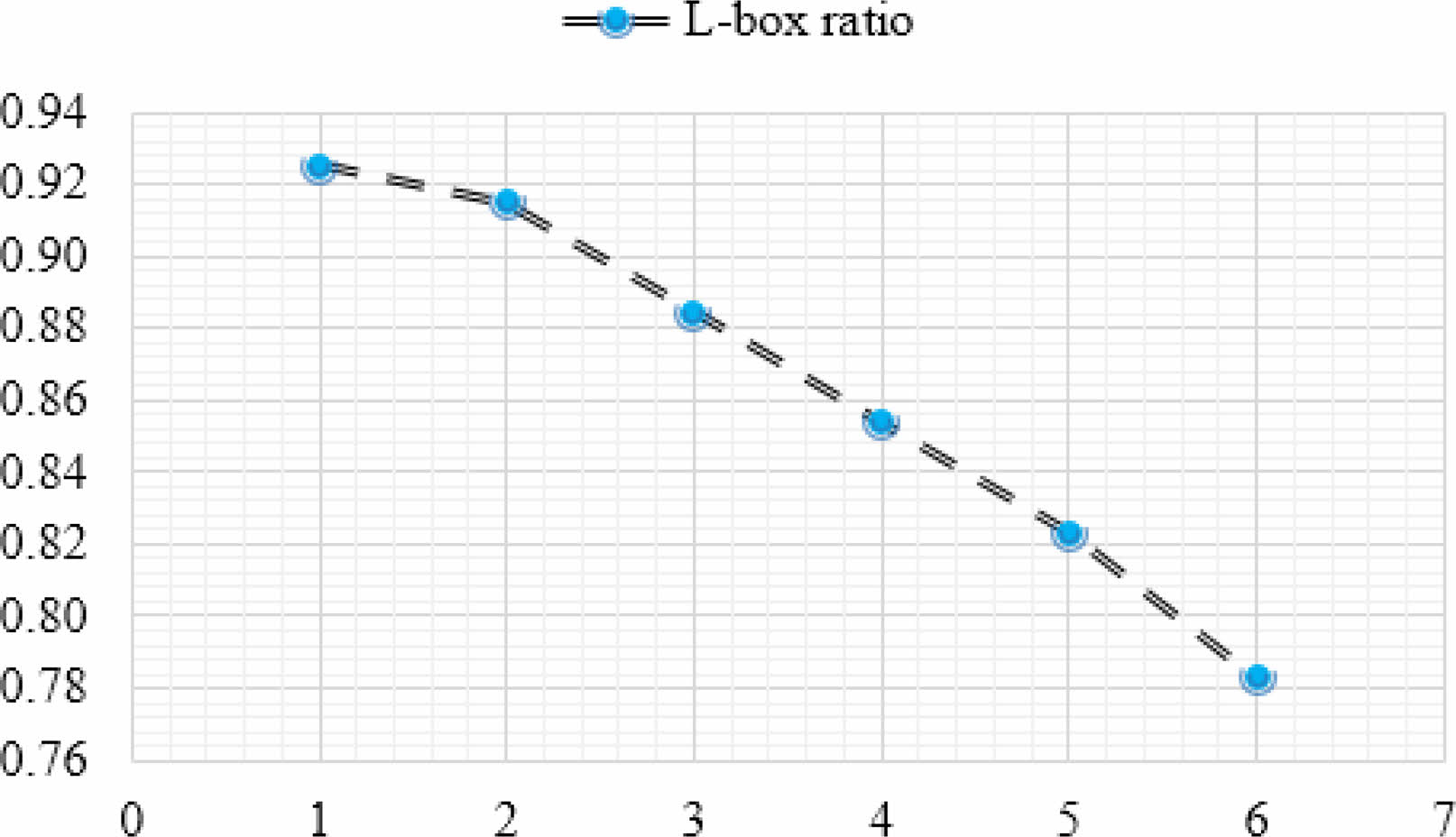
|
Fig. 3 Shows the graphical representation of L-box ratio. |

|
Fig. 4 Shows the graphical representation of J-Ring. |

|
Fig. 5 Shows the graphical representation of U-box. |
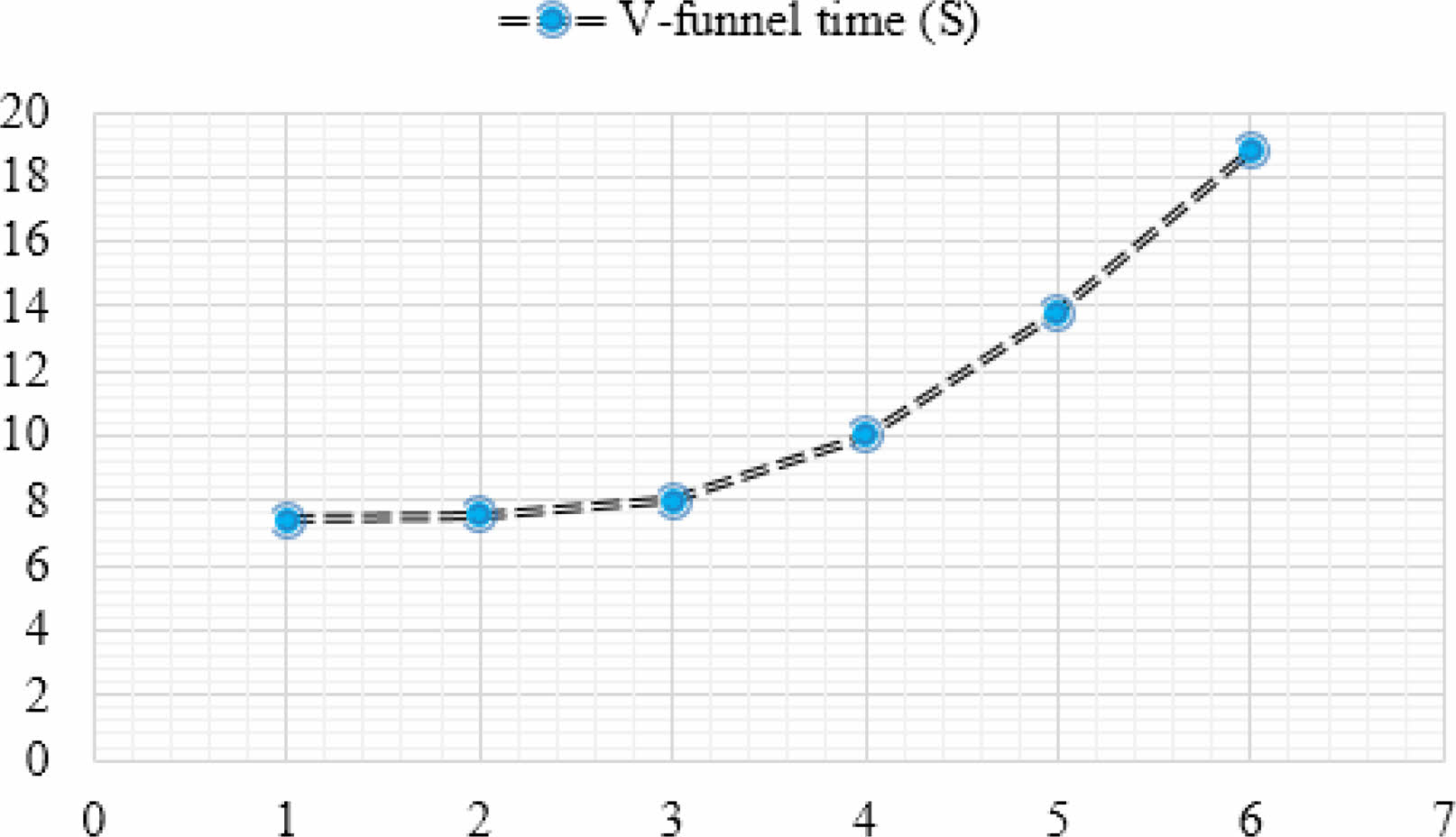
|
Fig. 6 Shows the graphical representation of V-funnel time. |
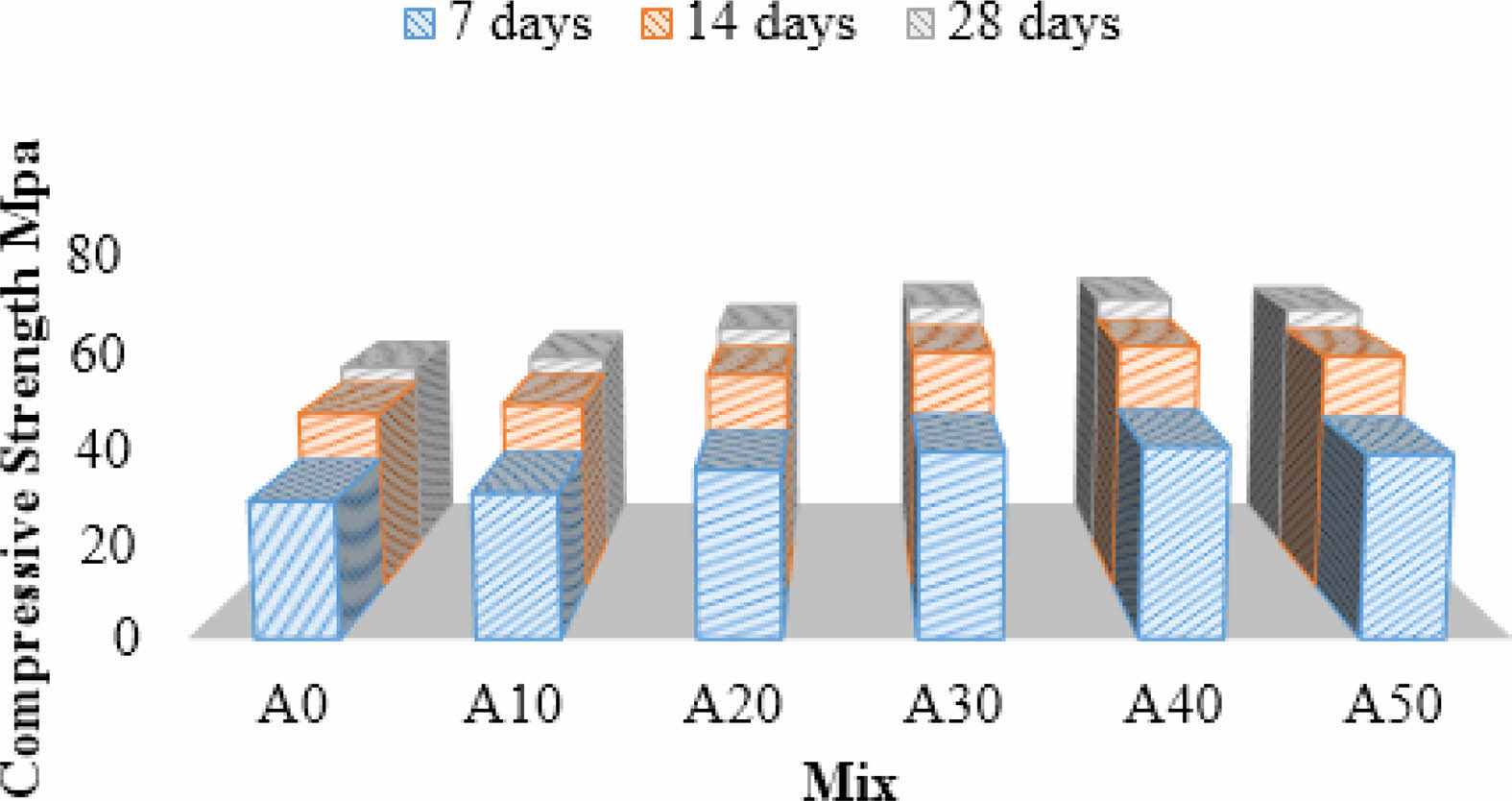
|
Fig. 7 Graphical representation of compressive strength test results. |
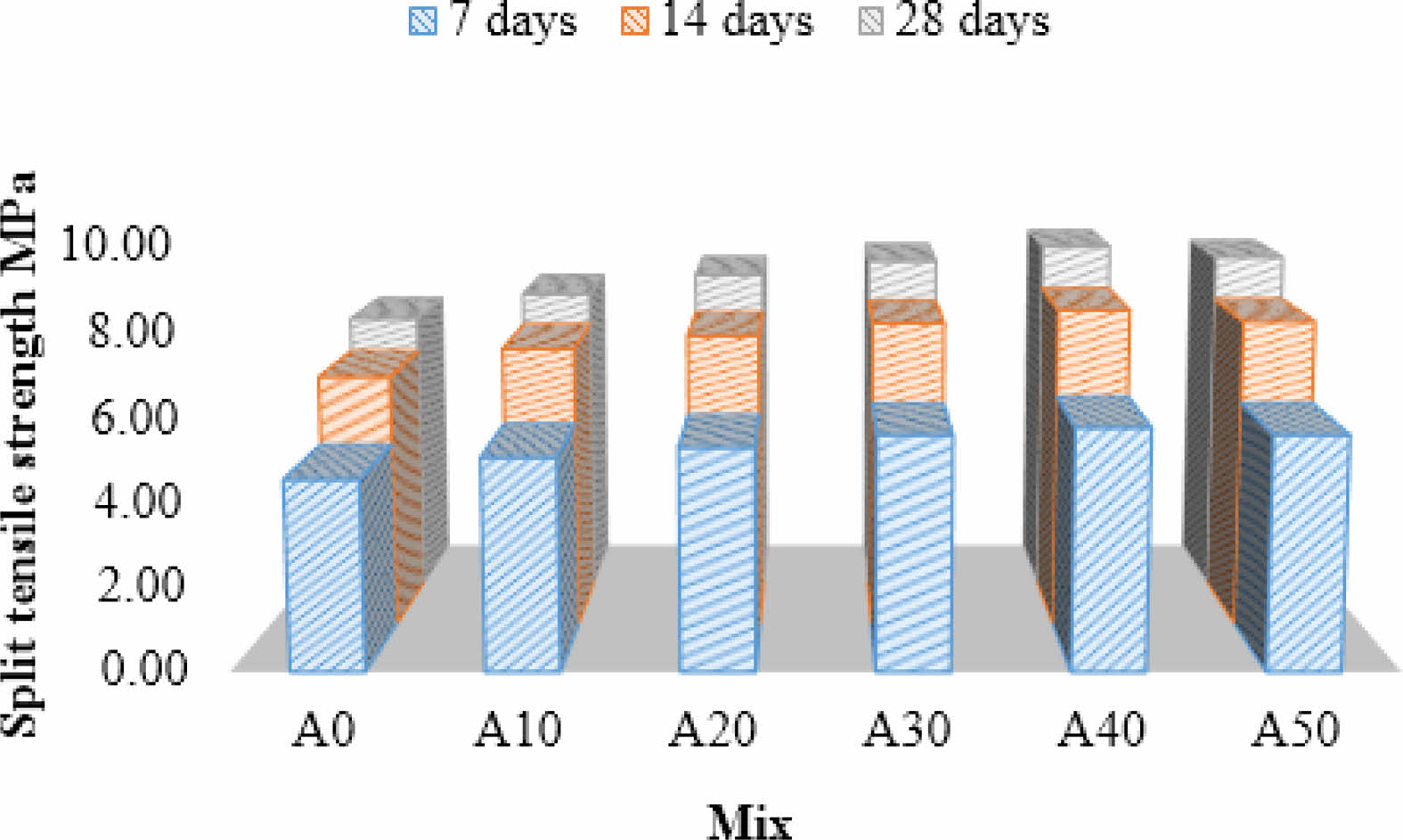
|
Fig. 8 Graphical representation of split tensile strength test results. |
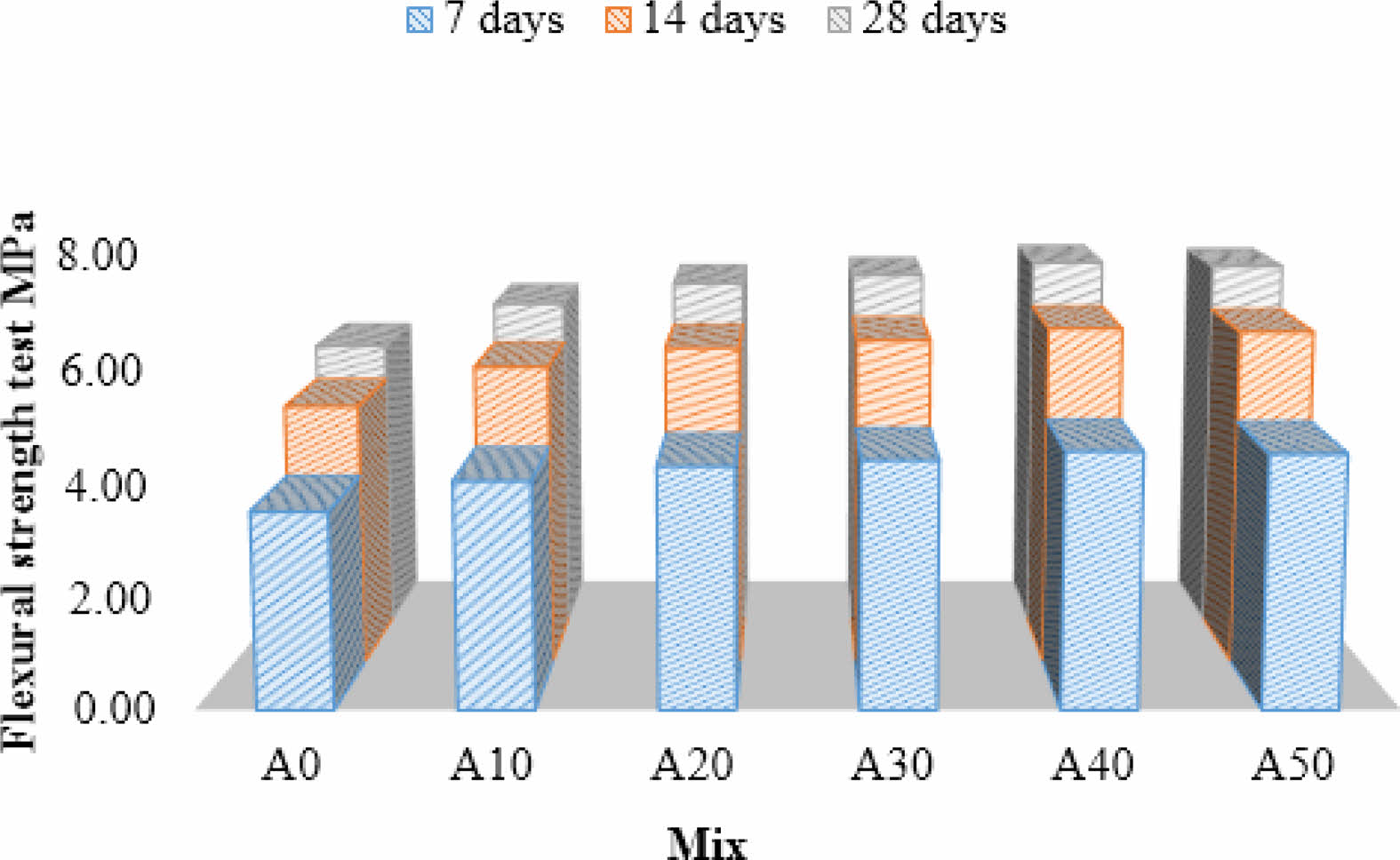
|
Fig. 9 Graphical representation of flexural strength test results |
Fresh Concrete Test
The slump cone test findings demonstrate a tendency toward decreasing slump values as Mix ID increases; at -8.75%, A50 exhibits the most negative percentage of variation. This implies that a more noticeable decline in the concrete mix’s workability is correlated with higher Mix IDs. The negative percentages suggest a decrease in the slumping tendency, which might point to problems with the concrete’s flow and formability. These results emphasize the need for more research and mix design optimization, emphasizing the need of carefully choosing the mix proportions to achieve desirable workability characteristics in concrete construction applications. Fig. 10 shows the graphical representation in percentage of variation in fresh concrete test.
Mechanical Properties of Concrete
The compressive strength results reveal a notable variation across different Mix IDs. A0 serves as the baseline with no percentage variation, while subsequent Mix IDs exhibit an increasing trend in mechanical properties. Mix A50 demonstrates the highest positive percentage variation at 24.94%, suggesting that higher Mix IDs contribute to enhanced mechanical properties. This indicates the potential influence of mix proportions on the structural integrity of the concrete, emphasizing the importance of selecting appropriate Mix IDs for achieving desired mechanical properties levels.Fig. 11 shows the graphical representation in percentage of variation in mechanical properties of concrete.
Durability Properties of Concrete
As Mix ID rises, the durability assessment shows a steadily declining trend in percentage variance. A0 is the baseline, meaning that there is no variance in durability; later Mix IDs show a progressive decrease in durability. Compared to the other mixes, Mix A50 shows a smaller negative percentage variation (-24.44%), which may indicate a gentler effect on durability. These findings suggest that concrete durability may be compromised by higher Mix IDs, with a more noticeable effect shown in A40. Fig. 12 shows the graphical representation in percentage of variation in durability properties of concrete.
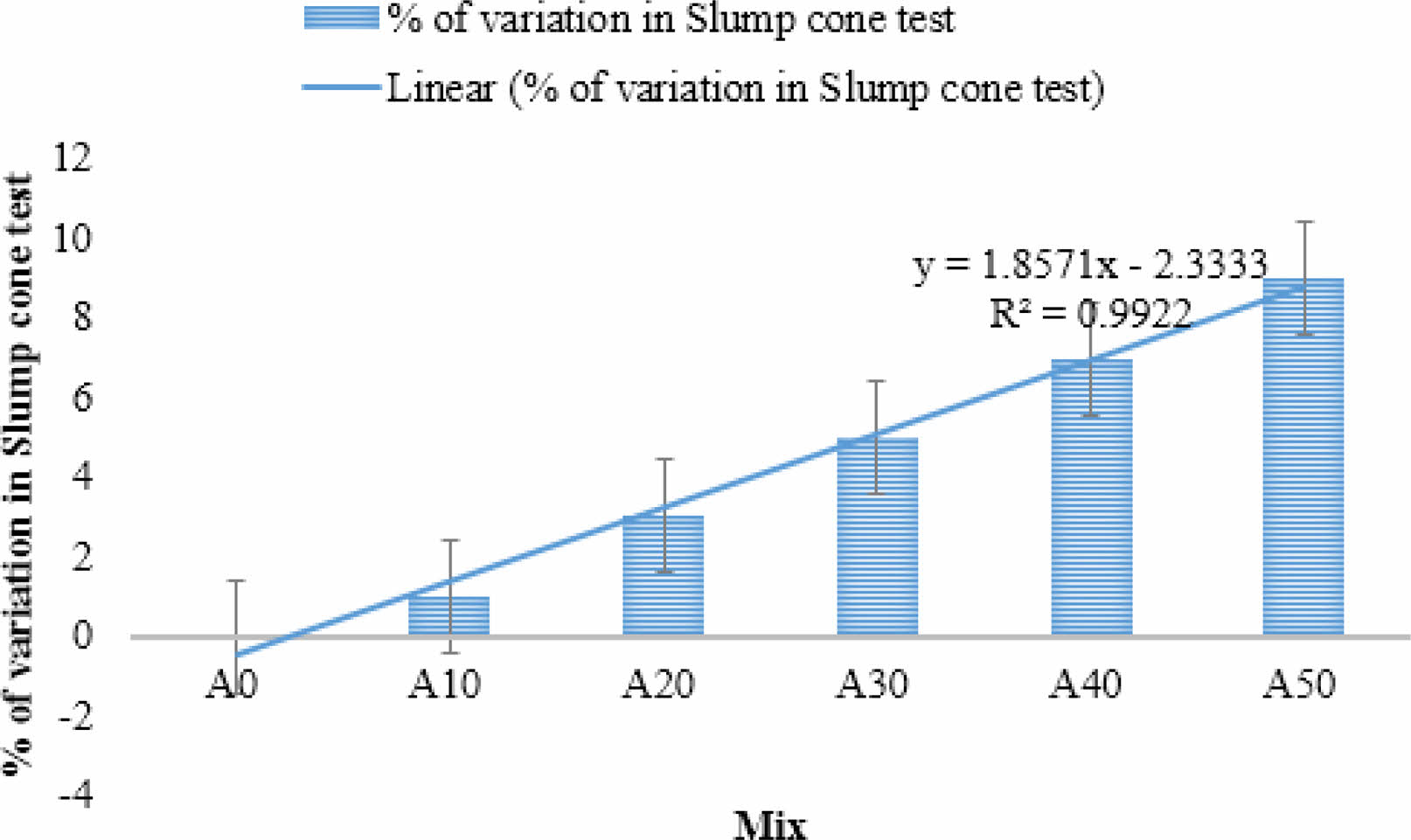
|
Fig. 10 Graphical representation in percentage of variation in fresh concrete test. |
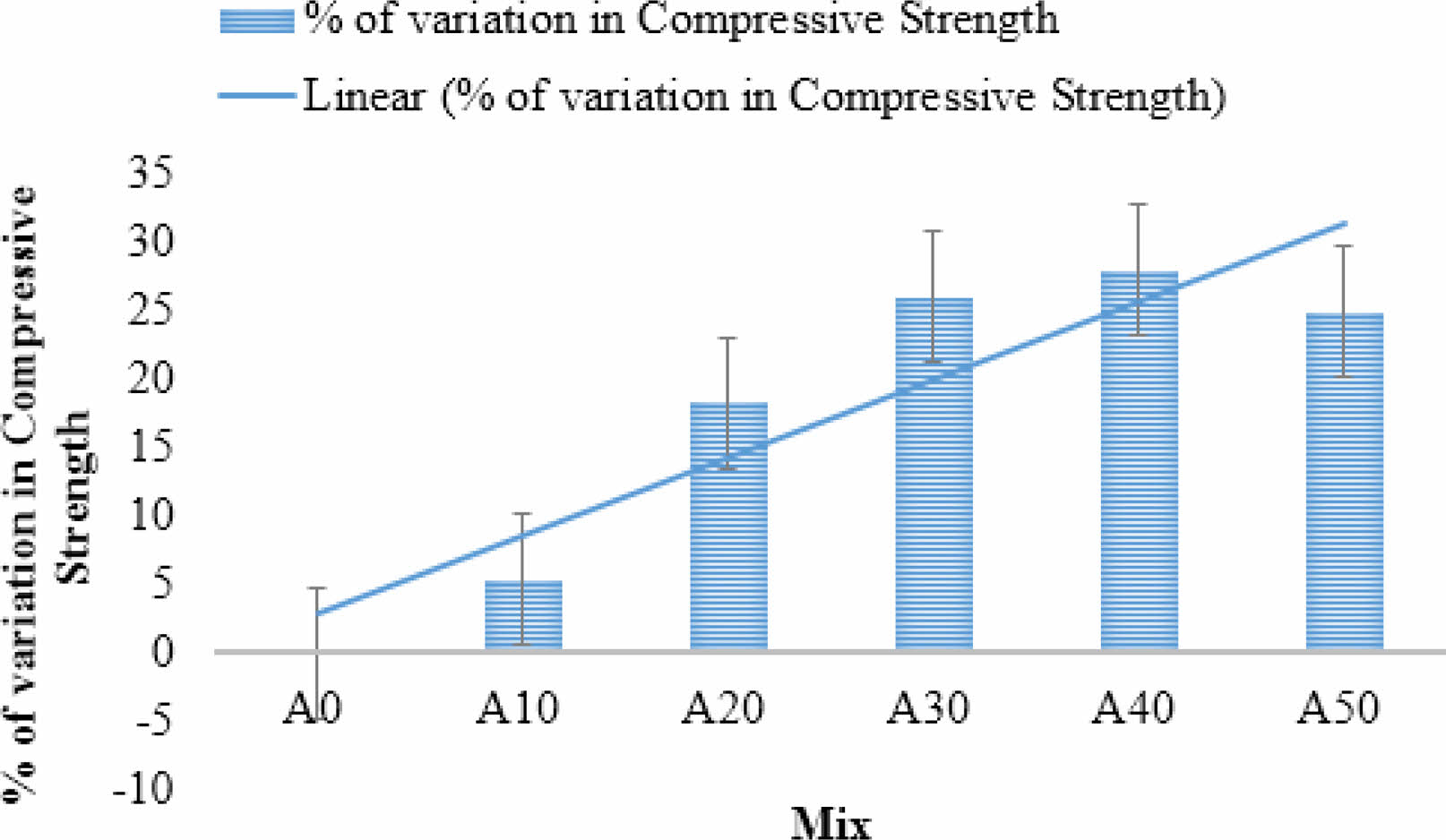
|
Fig. 11 Graphical representation in percentage of variation in mechanical properties of concrete. |
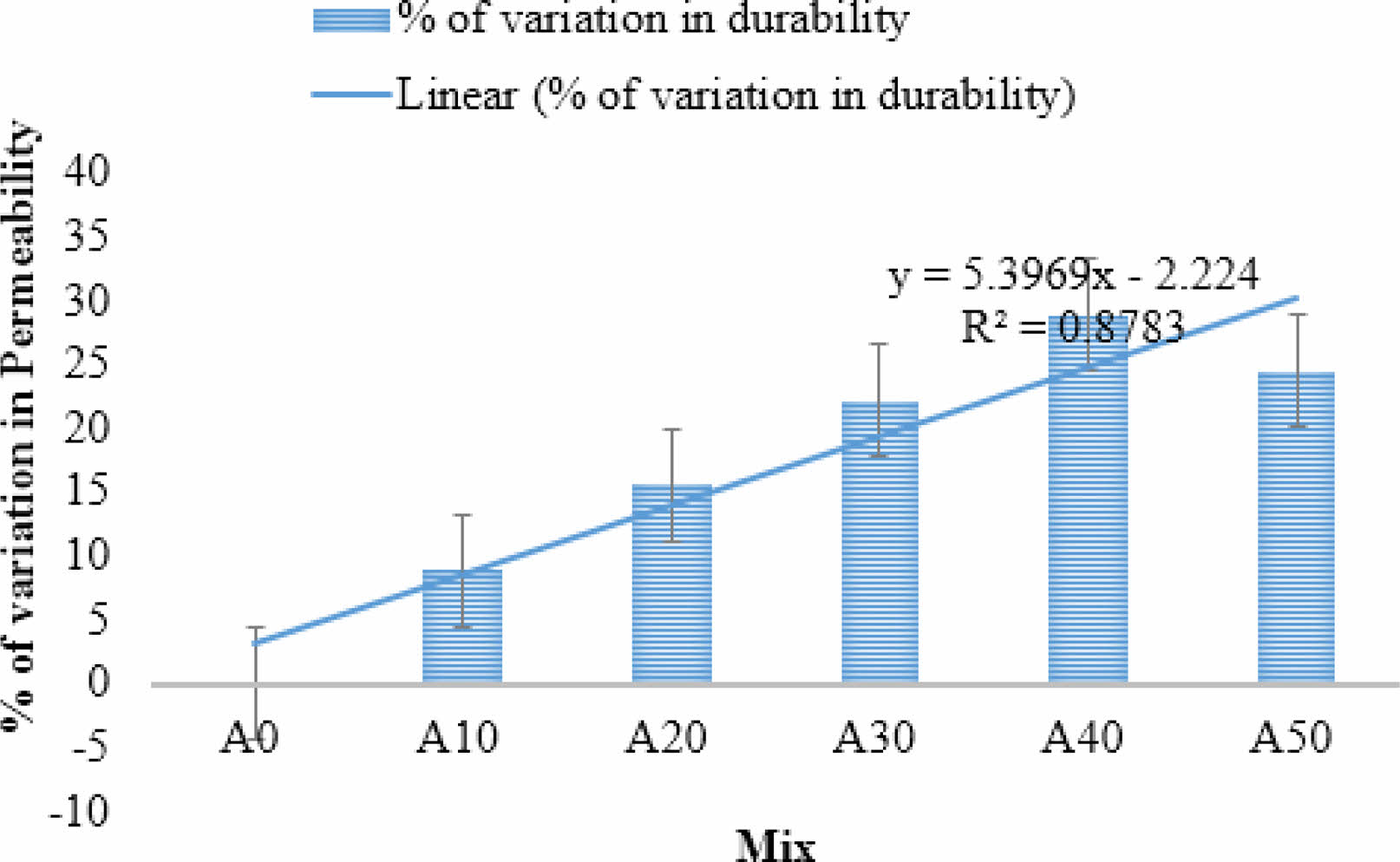
|
Fig. 12 Graphical representation in percentage of variation in durability properties of concrete. |
The purpose of this study was to investigate the benefits of using leftover ceramic tile as fine aggregate in SCC mixtures. To achieve this, self-compacting concrete mixes made using waste ceramic tile (WCT) underwent extensive examination, including mechanical, fresh, and durability investigations. The experiment’s results led to the following deductions:
As the replacement amount of WCT increased, it was discovered that the fresh qualities of SCC mixes decreased. Compared to reference concrete, the waste ceramic mixed SCC requires a higher dosage of super plasticizer. The addition of WCT changed the original qualities of SCC mixes, although it stayed within the EFNARC stand’s acceptable bounds. The reduction in workability is due to water absorption of waste ceramic tile is more compared to conventional aggregates.
The mechanical properties of SCC mixes are improved by using WCP in lieu of natural river sand, up to a 40% substitution level.
Due to the fact that WCT particles aid in the development of compact packing between aggregate and cement, the UPV of WCT containing SCC rises by up to 40% when compared to M-sand. In a similar vein, it also raises the density of mixes by reducing the water absorption, water permeability, and sorptivity of WCT-containing mixes at a specified replacement level (up to 40%).
The results of this investigation have validated the possibility of using leftover ceramic tile to make SCC that may be used in hot environments.
The authors extend their appreciation to the Researchers Supporting Project number (RSP2024R381), King Saud University, Riyadh, Saudi Arabia.
- 1. A. Anitha, V.G. Kalpana, and P. Muthupriya, J. Ceram. Process. Res. 24[1] (2023) 182-189.
-

- 2. A. Halicka, P. Ogrodnik, and B. Zegardlo, Constr. Build. Mater. 48 (2013) 295-305.
-

- 3. A.-A.M. Ismail, K. Kannadasan, P. Pichaimani, H. Arumugam, and A. Muthukaruppan, J. Clean. Prod. 264 (2020) 121689.
-

- 4. A.-B.M.A. Kaish, T.C. Odimegwu, I. Zakaria, and M.M. Abood, J. Build. Eng. 35 (2021) 102092.
-

- 5. A.-R. Pradeep, and M.-B. lingana Gowda, IOSR J. Mech. Civ. Eng. 13 (2016) 68-74.
-

- 6. A.-S. Kumaraswamy, K. Nirmalkumar, V. Sampathkumar, and S. Karthikeyan, J. Environ. Prot. Ecol. 23[2] (2022) 616-623.
- 7. B.-R.R.C. Anuradha, Int. J. Sci. Dev. Res. 4[9] (2016) 2321-0613.
- 8. C. Thamilpriyaa and G. Elangovan, J. Ceram. Process. Res. 24[3] (2023) 554-559.
-

- 9. M. Verapathran, S. Vivek, G.E. Arunkumar, and Duraisamy Dhavashankaran, J. Ceram. Process. Res. 24[1] (2023) 89-97.
-

- 10. D.-S. Vijayan, C. Nivetha, P. Dinesh Kumar, B. Saravanan, and V. Gokulnath, J. Green Eng. 10[6] (2020) 3084-3101.
- 11. S. Kumar, S. Gurusamy, V. Sivakumar, and S.M. Vaiyapuri, J. Ceram. Process. Res. 23[6] (2022) 869-877.
-

- 12. F. Pacheco-Torgal, and S. Jalali, Constr. Build. Mater. 24[5] (2010) 832-838.
-

- 13. F.F.G. de Paiva, J.R. Tamashiro, L.H.P. Silva, and A. Kinoshita, Constr. Build. Mater. 285 (2021) 122833.
-

- 14. A. Naveen Arasu, M. Natarajan, N. Balasundaram, and R. Parthasaarathi Glob. Nest. J. 25[6] (2023) 89-92.
-

- 15. G. Singh and R. Siddique, Constr. Build. Mater. 26[1] (2012) 416-422.
-

- 16. G.-E. Arunkumar, K. Nirmalkumar, P. Loganathan, and V. Sampathkumar, Glob. Nest. J. 25[5] (2023) 126-135.
-

- 17. M. Varuthaiya, C. Palanisamy, V. Sivakumar, and G. Pushpanathan, J. Ceram. Process. Res. 23[6] (2022) 912-919.
-

- 18. A. N. Arasu, M. Natarajan, and N. Balasundaram, AIP Conf. Proc. 2861[1] (2023) 050008.
-

- 19. K.-V. Boobala Krishnan, K. Nirmalkumarb, V. Sampathkumar, and P.-C. Murugan, J. Ceram. Process. Res. 24[4] (2023) 714-722.
-

- 20. M. Etxeberria, C. Pacheco, J.-M. Meneses, and I. Berridi, Constr. Build. Mater. 24[9] (2010) 1594-1600.
-

- 21. M. Shanmugamoorthy, S. Velusamy, A. Subbaiyyan, R. Yogeswaran, R. Krishnanbabu, and R. Senthilkumar, Mater. Today: Proc. 65 (2022) 920-924.
-

- 22. M.-K. Dash, S.-K. Patro, and A.-K. Rath, Int. J. Sustain. Built Environ. 5[2] (2016) 484-516.
-

- 23. N. Gurumoorthy and K. Arunachalam, Constr. Build. Mater. 123 (2016) 184-190.
-

- 24. N.-K. Bairagi, H.-S. Vidyadhara, and K. Ravande, Constr. Build. Mater. 4[4] (1990) 188-193.
-

- 25. P.O. Awoyera, J.M. Ndambuki, J.O. Akinmusuru, and D.O. Omole, HBRC Journal, 14[3] (2018) 282-287.
-

- 26. K. Syed, G. Elangovan, S. Vivek and A. Naveen Arasu, Rev. Mater. 29[1] (2024) in press.
- 27. R. Lin and L. Pang, J. Ceram. Process. Res. 20[3] (2019) 231-240.
-

- 28. R. Siddique and E.-H. Kadri, Constr. Build. Mater. 25[8] (2011) 3257-3266.
-

- 29. R.-J. Daniel and S.-P. Sangeetha, Mater. Today: Proc. 45 (2021) 6603-6608.
-

- 30. S. Fiore and M.-C. Zanetti, Am. J. Environ. Sci. 3[3] (2007) 135-142.
-

- 31. S. Monosi, F. Tittarelli, C. Giosuè, and M.-L. Ruello, Constr. Build. Mater. 44 (2013) 260-266.
-

- 32. S. Velusamy, A. Subbaiyyan, K. Ramasamy, M. Shanmugamoorthi, V. Vellingiri, Y. Chandrasekaran, and V. Murugesan, Mater. Today: Proc. 65 (2022) 549-553.
-

- 33. S.H. Eom, J.B. Lee, and S.H. Park, J. Ceram. Process. Res. 21[2] (2020) 164-169.
-

 This Article
This Article
-
2024; 25(2): 220-227
Published on Apr 30, 2024
- 10.36410/jcpr.2024.25.2.220
- Received on Dec 7, 2023
- Revised on Feb 24, 2024
- Accepted on Feb 26, 2024
 Services
Services
- Abstract
introduction
materials used
methodology
experimental investigation
results and discussion
regression analysis
conclusion
- Acknowledgements
- References
- Full Text PDF
Shared
 Correspondence to
Correspondence to
- P. Subashree
-
Department of Civil Engineering, Sri Krishna College of Technology, Coimbatore, Tamilnadu, India-641042
Tel : +91-8870393349 - E-mail: subashree.p@skct.edu.in






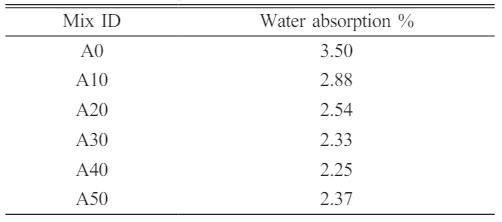
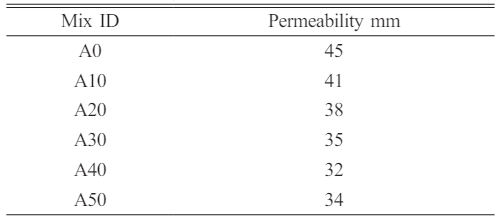
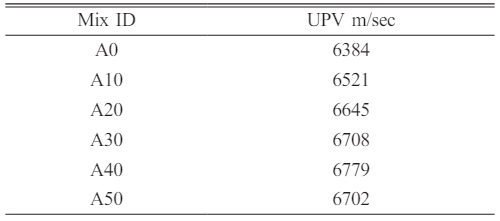
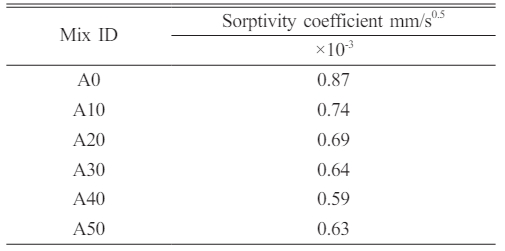
 Copyright 2019 International Orgranization for Ceramic Processing. All rights reserved.
Copyright 2019 International Orgranization for Ceramic Processing. All rights reserved.